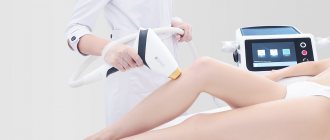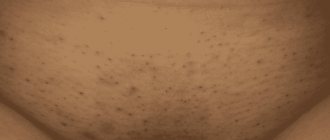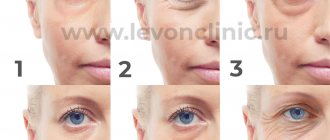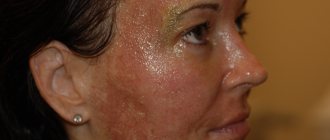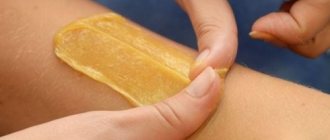After shaving or waxing, many of us face such a problem as ingrown hairs. Not only women, but also men are susceptible to this problem. You are faced with the question: “how to get rid of an ingrown hair?”, because this is not only a cosmetic defect. Ingrown hair causes pain, inflammation and a local increase in temperature. Let's look at what methods you can use to remove ingrown hair, and what measures will help prevent its occurrence.
WHAT DO GROWN HAIRS LOOK LIKE?
Ingrown hairs are not a dangerous skin disease, but they can cause a lot of inconvenience and discomfort to a person. An ingrown hair is a small, brown or reddish formation on the skin in the form of a tubercle with serous or purulent contents, in which the growing hair may or may not be visible.
Ingrown hairs occur due to the fact that after shaving, hair removal or depilation, hair grows deeper into the skin rather than outward, causing inflammation and irritation. This happens because dead skin clogs the hair follicle, causing hair to grow under the skin rather than up and out.
Shave correctly and we will be beautiful...
If you are familiar with the problem of ingrown hairs firsthand, remember: a body scrub should become your best friend! By the way, you don’t have to spend money on expensive branded products: natural abrasives will do the job, for example, ground coffee, granulated sugar with coconut or olive oil, honey with coarse salt. The main thing is to ensure exfoliation: if you remove the dead layer of skin at least once a week, you can free ingrown hairs without even noticing it. In addition, you need to make sure that you are using a sharp enough razor - old razors give a poor cut and injure the skin. When shaving, you should not pull on the skin - and if you have to do this, go back to the line above: most likely, your razor has become dull. A good modern machine easily glides over the skin by itself: for example, the Dorco Shai 4 women's razor is equipped with a floating head, which allows it to get even into hard-to-reach places - the groin area and armpits. In addition, this machine has a rubber micro-comb that lifts the hairs before shaving, thereby ensuring an even cut. And, of course, under no circumstances should you shave hair on dry skin - even if you found yourself embarrassed at the last minute before leaving the house, when you had already put on a dress with straps.
SYMPTOMS OF GROWN HAIR
In men, ingrown hairs most often appear after shaving in the beard area, on the neck, cheeks and chin. They can also appear on the surface of the head if a man shaves it. Ingrown hairs in women most often occur on the legs, bikini line and pubic area, armpits and around the buttocks. Signs indicating unwanted hair include the following:
• Hard bumps, small in size and round in shape (so-called papules);
• Small pustules that are filled with pus or serous contents;
• Itching, hyperpigmentation of the skin, pain.
General information
Ingrown hairs appear due to a change in their growth, when the shaft remains under the skin without breaking through the skin, and its growth occurs in the opposite direction. As a rule, this phenomenon, which is also called pseudofolliculitis , develops in those places where a person often removes unwanted hair.
Most often, this is observed on the face, legs, pubic area, and armpit area. In places where pseudofolliculitis develops, swelling and redness appear, and the skin may itch. Later, scars and pigmentation may remain in these places. Therefore, although such a disease is not dangerous, it can be quite unpleasant and cause significant discomfort. Very often, this phenomenon is observed in people of the Negroid race, as well as in those whose hair is very coarse. If such a problem is observed in certain areas of the skin, a person needs to reconsider the methods of dealing with unwanted hair and prefer professional hair removal methods.
How to overcome this problem and what to do if a person develops pseudofolliculitis will be discussed in this article.
REASONS FOR INGRONG HAIR
Ingrown hairs most often occur after hair removal in your own bathroom, but it happens that such an unpleasant phenomenon occurs after visiting beauty salons. In order to understand how to get rid of such a problem, you need to carefully understand what exactly provokes it. Cosmetologists say that the process associated with ingrowth directly depends on the number and density of epidermal layers. If the surface contains a significant number of cells of the stratum corneum, then they make the skin too rough, so it is difficult for thin growing hair to break through. For this reason, the hair begins to follow the path of less resistance, beginning to bend and grow horizontally, and not vertically, as is usually the case.
When considering skin and hair type, people with dark, coarse hair and dark skin are most susceptible to developing this problem. The reason is that this type of hair grows much faster than blonde hair. Add thick skin to everything else, and ingrowths can no longer be avoided.
Therefore, the reasons causing this unpleasant phenomenon include the following:
• thick layer of epidermis (hyperkeratosis);
• genetic predisposition;
• hormonal imbalance (for example, surges of estrogen observed at the beginning of the menstrual cycle). Changes of this kind can occur with high estrogen production, as well as with a disorder of the endocrine system;
• causing damage to the hair canal during the hair removal procedure;
• formation of a small scar in the hair canal after hair removal;
• curling of the hair below the level of the epidermis. This happens if mistakes were made during the hair removal procedure;
• shaving against the hair growth (especially when the blade is not new);
• constant wearing of uncomfortable underwear made of synthetic material. Such underwear does not allow moisture to evaporate from the surface of the skin and often leads to the development of bacterial infections. It is because of this that after hair removal it is not recommended to immediately put on synthetic underwear.
It is imperative to get rid of ingrown hairs, but before carrying out such a procedure, you must understand what not to do.
WHAT NOT TO DO WHEN REMOVING AN INGRONG HAIR
Most people try to cope with the problem with the help of improvised objects, but such actions often lead to complications. Therefore, below is a list of actions that should be avoided:
• Use tweezers or an overly sharp needle without preliminary treatment - such manipulations can lead to infection and further inflammation;
• Do not press the hair follicle in the place where the hair grows, because this can lead to the effusion of serous or purulent contents deep into the skin.
Diet
Diet for skin diseases
- Efficacy: therapeutic effect after a month
- Time frame: three months or more
- Cost of products: 1400-1500 rubles per week
Food should be varied and nutritious. It is important to avoid deficiencies of minerals, vitamins and other beneficial substances in order to prevent problems with the skin, as well as other organs and systems of the body.
The menu must include vegetables and fruits in large quantities, meat, dairy products, and sea fish.
WAYS TO REMOVAL INGRONG HAIR
What to do if hairs begin to grow in after depilation? They must be carefully removed so as not to cause additional inflammation. You can get rid of ingrown hair using the following methods:
• If they are not too deep and there is no inflammation, simply steam the skin and perform a home chemical peeling or scrubbing. You can also use a hard washcloth or a special mitten to remove dead cells of the stratum corneum. Dead cells can be removed every other day, and the skin after such procedures should be treated with a moisturizer or lotion.
• If there is inflammation, but there is no purulent vesicle or the hair is deeply embedded, mechanical hair removal is performed. This method is described in detail below. Mechanically ingrown hair can be removed at home, but it is better to leave this procedure to a specialist to avoid complications.
• Surgical removal of an ingrown hair is carried out when a pustule with serous or purulent contents forms and there is extensive inflammation. This procedure can be performed by a surgeon in a regular clinic. The surgical method of removing ingrown hair involves opening the abscess, sanitation of the wound and removing the hair. The wound is treated with an antiseptic and a bandage or bactericidal adhesive plaster is applied.
• Photoepilation is carried out only in a cosmetology salon. Ingrown hairs are destroyed by a light pulse. Not suitable for very light and gray hair.
• Electrolysis is also carried out only by a cosmetologist. Ingrown hair is removed even at great depths using a needle-electrode through which an electric current is passed.
• Laser hair removal. The most widely used and effective technique today, it can be used on skin of any color.
Hardware procedures are carried out only in the absence of inflammation and suppuration.
• To solve these problems, you can also use traditional methods for removing ingrown hairs; they will help draw the hair shaft to the surface of the skin. To help the hair break through the skin, you need to prepare a compress of several aspirin tablets, one spoon of glycerin and water. This lotion treats the problem area. As a result, the hair itself will begin to grow outward, and it will need to be removed with tweezers, after which do not forget to disinfect the skin with an antiseptic. Another lotion option: make a paste of bodyaga powder and hydrogen peroxide and apply to the ingrown hair for 10-15 minutes, then rinse. If the burning is severe, wash off sooner.
Mechanical removal of ingrown hair at home
Step-by-step instructions will help you remove ingrown hair at home. For this manipulation, you need to stock up on a thin sterile needle (if the hair has grown deeply) and manicure tweezers. Before starting the procedure, medical tweezers must be treated with medical alcohol or an antiseptic (chlorhexidine).
1 step. We steam the skin in the shower to expand the pores as much as possible. Using a scrub, we get rid of the dead layer of skin.
Step 2. The area of the ingrown hair is also treated with alcohol or an antiseptic.
Step 3. You need to find the tip of the hair and carefully pick it up with a needle, slowly pulling it out, clamp the protruding hair with tweezers and pull it out by the roots. At this stage, it is extremely important not to break off the hair and remove it entirely, otherwise it will grow back.
Step 4 Lubricate the skin with an antiseptic or, better yet, an alcohol tincture of calendula, which has an anti-inflammatory effect.
This method is suitable only in situations where ingrown hairs are clearly visible.
Prevention of ingrown hair
Ingrown hair on the leg is a phenomenon that can be prevented. There are several simple and generally accepted rules for caring for the skin of your feet:
- Before depilation, the skin of the legs must be prepared. Take a hot shower first to clean and steam the skin on your legs and soften your hair.
- Before removing hair, you must use peeling products.
- When removing leg hair with a razor, you need to make sure it is sharp enough.
- After completing the procedure, a post-depilation emollient and moisturizer is applied to the skin.
It is best to perform the depilation procedure at night before going to bed so that your legs have time to rest and recover during the night. If irritation and inflammatory processes appear on the skin, depilation should be avoided.
Prices:
| Code | Name of service | Prices |
| 1 | Initial appointment | 1200 |
| 2 | Repeated appointment | 900 |
| 3 | Calling a surgeon to your home | 3500 |
| 4 | Abdominal ultrasound | 2200 |
| 5 | Ultrasound of veins and vessels | 2400 |
| 6 | Doppler 2-3 trimester | 1200 |
| 7 | Rectoscopy | 1500 |
GROWN HAIR IN THE BIKINI AREA
Sometimes a fine ingrown hair in the groin cannot be seen through the skin. In this situation, we soften the epidermis so that the hair is closer to the surface. To do this, apply a steaming compress to the skin or take a bath. Please note that such manipulations can be performed in the absence of inflammation. As soon as the hair becomes noticeable, we perform mechanical removal of the ingrown hair. All instruments you will use must be sterile. If after steaming the hair still does not become visible, then do not try to get rid of it. In this situation, it is best to seek qualified help from a cosmetologist. At the same time, a specialist will help you figure out what exactly caused the compaction to appear.
Pathogenesis
The development of pseudofolliculitis is due to the fact that the growth of follicle hairs is prevented by the skin or epithelium. As a result, the hair does not grow straight, but begins to grow into the surrounding skin. This provokes an inflammatory reaction, redness and irritation of the skin. of microabscesses , as well as infiltrate , which appears as a reaction to a foreign body, may occur Sometimes psefdofolliculitis leads to fibrosis of the dermis, which leads to the appearance of papules, pustules, and hyperpigmentation. Sometimes, after an advanced ingrowth is removed, scars remain on the skin.
GROWN HAIR IN THE ARMPITS
This is perhaps the most unpleasant option. Firstly, the skin in these places is extremely thin and is constantly irritated. Secondly, removing unwanted hair on your own will bring a lot of discomfort. Finally, due to the use of deodorants and increased sweating, pain is often felt in the area where such a hair is located and inflammation occurs due to infection. Therefore, the operation must be carried out extremely carefully:
• A few days before removal, we begin preparations - we treat the skin with an anti-acne preparation, which contains salicylic acid. Such lotions are too aggressive for the face, but in the area of hair growth they lead to thinning of the skin and stop the inflammatory process;
• Just before removal, remove the remaining salicylic ointment, steam the skin, and treat all instruments;
• If all the previous steps are completed correctly, then even with the naked eye it will be possible to see the ingrown hair. We carry out the hair removal procedure and wipe the area with an antiseptic.
What is the danger?
Self-removal of hairs with an instrument can provoke infectious penetration into the follicle and the transformation of nodules into pustules . The chronic version can result in unpleasant consequences:
- bacterial infection due to damage;
- darkening of the skin - pigmentation;
- unsightly scars, keloid scars;
- folliculitis - inflammation of the follicle.
MEDICINES USED TO TREAT INGRONG HAIR
After visiting a cosmetologist, you may be prescribed some medications that will help get rid of the annoying problem. This list includes:
• Retinoids. In some situations, the doctor prescribes creams that help remove dead cells from the surface (so-called peeling). These include the drug tretinoin. They help relieve hyperkeratosis, which is thickening, and hyperpigmentation, a darkening of the area that is often seen on dark skin that is prone to ingrown hairs;
• Corticosteroids. A good steroid blend helps control inflammation;
• Antibiotics. Ointments based on antibiotics can prevent infection that occurs due to damage to the painful area. If the infection is severe, oral antibiotics may be prescribed for treatment.
